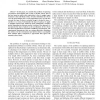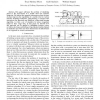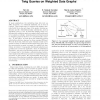36 search results - page 2 / 8 » How to trust robots further than we can throw them |
ICRA
2006
IEEE
14 years 1 months ago
2006
IEEE
— In this paper, we consider the problem of exploring an unknown environment with a team of mobile robots. One of the key issues in multi-robot exploration is how to assign targe...
ICRA
2005
IEEE
14 years 1 months ago
2005
IEEE
— This paper addresses the problem of classifying places in the environment of a mobile robot into semantic categories. We believe that semantic information about the type of pla...
IJCNN
2008
IEEE
14 years 2 months ago
2008
IEEE
—A novel wake-sleep learning architecture for processing a robot’s facial expressions is introduced. According to neuroscience evidence, associative learning of emotional respo...
ICSE
2000
IEEE-ACM
13 years 11 months ago
2000
IEEE-ACM
Software's increasing role creates both requirements for being able to trust it more than before, and for more people to know how much they can trust their software. A sound ...
VLDB
2007
ACM
14 years 1 months ago
2007
ACM
In many applications, the underlying data (the web, an XML document, or a relational database) can be seen as a graph. These graphs may be enriched with weights, associated with t...



